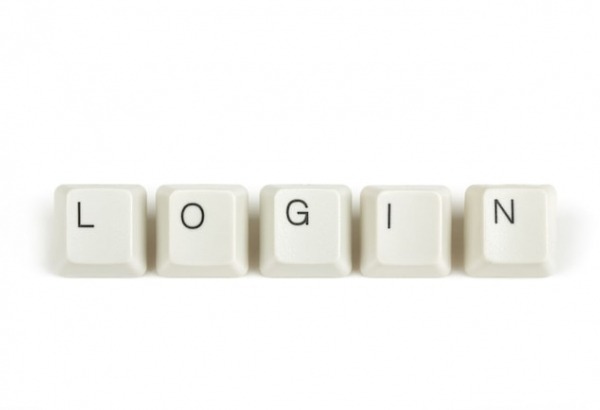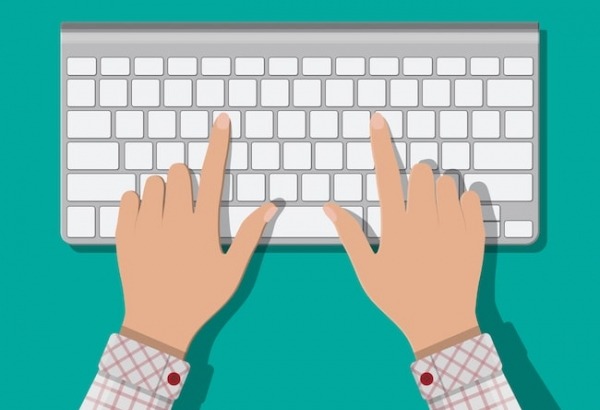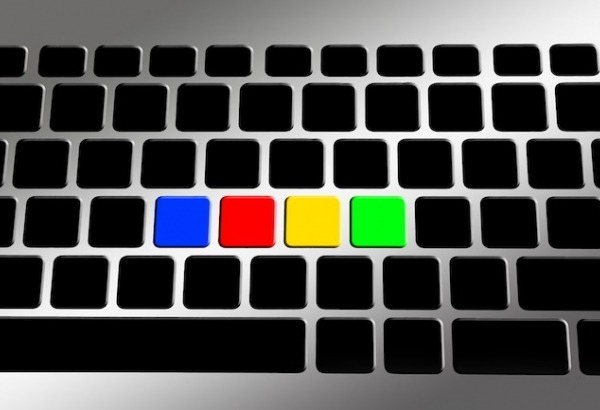Teach yourself to type

Most adult learning programs and libraries offer basic skills computer courses, but is it possible to learn how to touch type on your own? Of course. If you have access to a computer, there are plenty of self-study programs that can help you get started.
One of the first things you need to learn is the home-row position on the keyboard – also known as the home keys. This is where you place your fingers when your hands are at rest. As you look down at the keyboard you’ll see tiny bumps on the F and J keys to help you find the correct starting position. Line your fingers up with your left index finger resting on the F and your right index finger resting on the J. Between your index fingers you’ll see G and H. You should practice finding the home keys by touch alone.
A self-study course will then provide guidance on which fingers are used to type which keys, and how to use combinations of key presses to type capital letters and punctuation marks.
3 Things to consider when you’re learning how to touch type
- The letters and words you type are important.
That’s because they should familiarize you with the most common letter combinations in English. In this way movement patterns will feel more comfortable, and reaching for certain keys will feel less awkward, when you begin typing real words.
- How often and how long you practice are important.
If you aren’t practicing frequently enough, it will be harder to commit the movements to memory and turn them into procedural knowledge. If you sit down for a very long touch typing session, you may feel tired and frustrated by the end, and this can lead you to make more mistakes and feel demotivated. Try shorter, frequent sessions.
- How you sit at the computer, your keyboard, and the angle of your wrists, are important.
You want to bend your arms at a 90 degree angle so your wrists are straight – this will prevent wrist injury and pain. Think of the position as one you might adopt if you were playing the piano. In some cases, you may want to explore different keyboard options, for example if you have very small or very big hands or are only able to type using one hand. It’s important that your chair and desk are at the right height. This is so your wrists are hovering over the keyboard and you’re not dropping your hands and putting pressure on the nerves on the underside of your wrists.
What is touch typing?
Touch typing refers to the ability to find letter keys without looking at the keyboard. Using your sense of touch frees your eyes to focus on the screen, and your brain to focus on the content of your writing. For this same reason note-taking and copying are also made easier by touch typing.
The benefits of typing
Learning to touch type can improve your speed and efficiency at the computer. Typing skills can also help you grow your confidence at school and/or in the workplace. Depending on how you learn, typing might improve your spelling skills and writing fluency too. Learn more about the benefits of touch typing.
For a range of reasons, some people struggle with the physical process of writing by hand. Typing, however, can become automatic and much easier to do.

Learning the position of the keys
Most self-study typing programs present one key at a time and drill you until you feel comfortable reaching the keys you know. When you are studying typing on your own, you may choose to learn one key and then practice typing it in alternation with the other keys you have learned.
You’ll find it more effective not to confine yourself to just typing the key on its own or in nonsense sequences. Practicing with real words and word parts can eventually lead to greater gains in typing speed and spelling ability.
What if you find yourself looking down too often?
There are a few approaches you can try. You might cover your hands with a tea towel/dish cloth, use a turned over cardboard box with two half circles cut into it to let the hands in, or even in extreme cases decide to apply stickers or paint over the letters on the keys. Just remember for these last two it will make it harder for anyone else who can’t touch type to use your device.
Technique is crucial
How well you’re touch typing can be one thing that’s hard to judge when you’re learning on your own. One idea is to video your hands while you’re at the keyboard. Next, go on YouTube and compare your performance to that of a touch typist.
Note, this is also useful if you find you’re struggling with a particular key or key combination. You can make a video documenting the issue and then post it on a typing forum or ask an expert/tutor for targeted advice.
Another technique you can try is to temporarily place a bit of Blu-tack on the key or keys to help you master the particular reach without looking. Practice makes perfect.
The first signs of success
As you strengthen the muscles in your hand and the key-press movements become more familiar, you’ll start to type more fluently. That’s when you’re likely to see a boost in speed and a reduction in the amount of typos you make. Your speed on high frequency words will develop first. This is because you are typing a set of keys repeatedly, so the pattern becomes procedural knowledge.
As you begin using your new typing skills for work and school, writing emails, reports, essays and other electronic documents, you'll find you’re even more comfortable on the keyboard. Ideas may seem to flow directly from your brain through your fingertips and onto the screen. That’s why it’s so important to persist in learning the correct fingering.
Just be aware, it can take a while to get to this point and you may be a bit slower when you first start touch typing as you're learning the correct fingering. It's also hard to break free of old two-finger typing habits. But don't be dismayed, just keep pushing ahead and practicing.
Get the most out of your typing
If you are learning to touch type for work or school, you may want to spend some time assembling a list of words that are common in your industry or area of specialization. Create your own drills and you’ll find you get better at typing those words faster.
If you struggle with spelling, you can also try drilling a list of top misspelled words. This should convert your knowledge of letters and letter order into a sequence of key presses. You may find your spelling uncertainties disappear as the muscle movements take over.
Teaching children to type
If you can teach yourself to type, can you help your children learn too? Why not!
Children age 7 and over (i.e. once their hands are mature enough to sit comfortably on a keyboard) can benefit from learning to type as it strengthens their emerging literacy skills. You might even introduce a keyboard to younger learners to help with letter identification, just don’t expect them to actually type as their hands may be too small and their muscles underdeveloped.
Some children prefer games-driven, animated experiences when it comes to self-study typing lessons. Others, particularly those with learning or attention difficulties, may need a less busy interface that helps them focus on acquiring the skill itself.
By providing children with typing lessons you are giving them a means to complete school assignments more quickly and efficiently. Plus, it’s a skill that will help them later on in life, at college and even in the workplace. Learn more about teaching kids to touch type.
What if you're struggling with typing?
It can take different people different amounts of time to learn typing. There’s no set period in which skills emerge as it depends on your background, previous experience with typing, and how often and consistently you practice.
If you’re finding it difficult, you can always sign up for a face-to-face class with a teacher who can give you feedback on hand position/technique and troubleshoot issues that are common among beginner typists.
Another approach is to try a self-study program that teaches typing in a different way. Many people who have not been successful learning on their own or with free online programs have benefited from Touch-type Read and Spell. This is because it takes a multi-sensory and self-paced approach to typing.
With multi-sensory typing you hear the letter or word, see it on screen and then type it (with or without on-screen hand guides to show you the keys). In TTRS, instead of learning groups of nonsense keys, you learn vowels first and then add in consonants. You’re typing real words from the beginning.
Touch-type Read and Spell was originally developed to help individuals who struggle with dyslexia. It’s highly accessible and has a range of settings you can adjust to improve your experience. As a bonus, the order of the words in the course reinforces English phonics, so you’ll improve spelling and reading skills without even trying.
Top tip:Touch-type Read and Spell can be used for both children and adults
For anyone looking to learn touch-typing
Touch-type Read and Spell (TTRS) has a course that can help, especially if you’ve tried other typing programs and not been successful.
Chris Freeman
TTRS has a solution for you
An award-winning, multi-sensory course that teaches typing, reading and spelling

How does TTRS work?
Developed in line with language and education research
Teaches typing using a multi-sensory approach
The course is modular in design and easy to navigate
Includes school and personal interest subjects
Positive feedback and positive reinforcement
Reporting features help you monitor usage and progress














